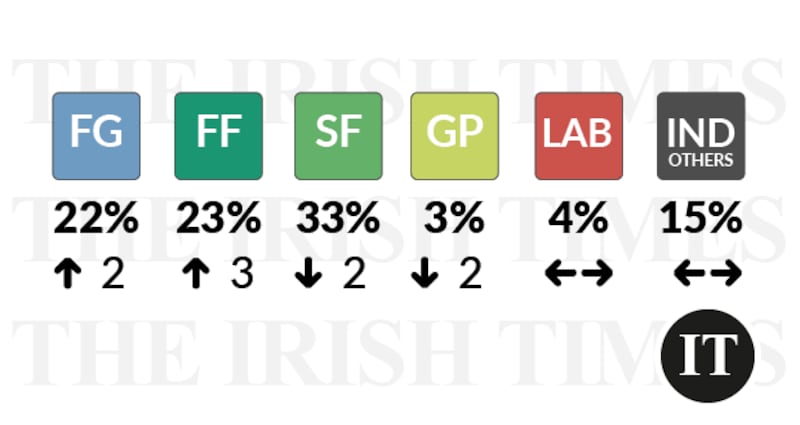Signs of a modest recovery for the two big Government parties, a stalling of the Sinn Féin juggernaut, beginnings of a worrying trend for the Green Party and absence of any polling encouragement for the new leader of the Labour Party – these are the outstanding features of the first Irish Times/Ipsos opinion poll of 2022.
The poll is also the first since the threat from the Covid-19 pandemic definitively waned and life began to return to normal. In tandem with this, something like normal politics is beginning to re-emerge. The last poll was dominated by Covid, as had been every poll for the previous 18 months. But no longer.
That said, the new normal is quite different to the old one. The war in Ukraine and the associated – though independent – cost of living crisis have joined the housing squeeze and the health waiting list on the Government’s crowded in-tray. Not for nothing does Mary Lou McDonald reference the impact of cost-of-living increases on ordinary people in practically every Dáil outing against the Taoiseach.
The constant refrain from Sinn Féin – and the rest of the Opposition – is that the Government “must do more” on tackling price rises. But the evidence from today would suggest that many voters realise that the Government has limited influence on many cost increases, and limited resources to mitigate them.
Fianna Fáil and Fine Gael see increases in support today. We have not seen that happen since the Coalition was formed, almost two years ago.

That alone would make it the most positive poll for the Government for a long time. But there are other factors to cheer the old rivals-turned-colleagues too.
Leo Varadkar and Micheál Martin see their personal ratings improve, Martin’s by a chunky eight points to 51 per cent, his highest satisfaction rating ever and top spot among the party leaders for the first time since he became Taoiseach. The strengthening of Martin’s position, with the public and his own party, has been apparent for some time, and this is further evidence for it.
For Varadkar, the gain is more modest – up by three points to 48 per cent. But it is still healthy territory for him and given the long and apparently inexorable decline in Fine Gael’s fortunes until today – the party had dropped in every single poll since October of 2020 – perhaps he will be the happiest of all.
Politics being an inherently competitive world, Fine Gael and Fianna Fáil will also take encouragement from the decline in support for Sinn Féin, and the drop in Mary Lou McDonald’s personal rating. After steadily rising to 35 per cent over the 18 months to last December, Sinn Féin falls slightly by two points to 33 per cent today, with McDonald seeing a similar drop in her personal rating from 44 per cent 42 per cent.
The changes cut the gap between Sinn Féin and its nearest rival from 15 points to 10, and if you are minded to view Fianna Fáil and Fine Gael as essentially the same political force – and many Sinn Féin supporters are – then the combined FF-FG vote is 12 points ahead of Sinn Féin.
For sure, McDonald is still on course to lead the largest party in the next Dáil and the growth in Sinn Féin support remains the most important medium-term trend in Irish politics. But the question of how she might come to lead the next government remains an open one, and it is not made any clearer by today’s numbers.
Satisfaction will not be universal across Government. The Green Party is starting to see what many of its members and very many pundits predicted – the haemorrhaging of its support while in a Coalition with larger parties. The Greens drop by two points today, which follows a two-point decline in December also. And Eamon Ryan’s personal satisfaction rating slumps by six points, from 25 to 19 per cent.
Green influence
The Greens are having an outsized impact on Government policy, with climate action measures locked into law and central to the Coalition’s priorities. But this is a double-edged sword: while committed Green voters might like it, at least some of those measures – think of the carbon tax increases, for one – will not be popular with chunks of the electorate, nor with softer Green voters.
Today’s numbers are unlikely to dim the Greens’ commitment to implementing further measures – but they might make the politics of that more difficult. Political weakness sucks away a leader’s and a party’s capacities.
What else? It’s the first poll for new Labour leader Ivana Bacik. But the Bacik bounce, if such a thing was anticipated by her supporters, has not materialised. That is not perhaps surprising, or even worrying, for Labour whose resuscitation (like that of all small parties) depends more on strong candidates in a handful of constituencies than it does on a national leader knocking things out of the park on the floor of the Dáil.
But given that part of the rationale for getting rid of Alan Kelly was his failure to lift the party in the polls, Bacik’s backers have some cause for concern. Early days, though.













